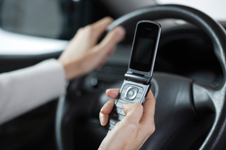3Qs: Would cellphone ban dial back ‘distracted driving’?

The National Transportation Safety Board (NTSB) — an independent federal agency responsible for investigating transportation accidents and promoting transportation safety — called for a complete end to cellphone use while driving, as opposed to bans in some states that still allow talking on hands-free devices. Here, Judith Perrolle, an associate professor of sociology and an expert on the social impact of technology, explains the dangers of using a cellphone on the road, safer technology alternatives and the societal impact of such a ban.
Why has the NTSB called for a complete ban on cellphone use while driving?
The problem with cellphone use by drivers is part of what transportation safety experts refer to as “distracted driving.” Automobiles are the most dangerous technology in the United States, leading to the deaths of more than 33,000 people last year. The NTSB estimates that distracted driving was the cause of about 10 percent of fatal accidents. Despite claims by some researchers, most studies show that humans are not really very good at multitasking. Cellphone use causes most people to take their hands, their eyes and their attention away from driving. Also, many hands-free systems are not really hands-free, but rather, require users to look at or handle their phone for some tasks.
What are the challenges of implementing such a drastic societal change?
People who use their cellphones for work and while driving would be seriously inconvenienced by a more widespread adoption of the hands-free ban. For most, however, banning cellphone use while driving would not be a drastic change, especially for those who are already unable to use their cellphones at work for personal calls, on airplanes or in other settings. According to the NTSB, 70 percent of U.S. states already ban texting while driving, and 60 percent ban cell use by new drivers. One in five states currently bans hands-free cellphone use.
What improvements can be made to digital technology to enable drivers to talk safely on the road?
An obvious improvement would be interfaces that are eyes-free as well as hands-free, allowing people to listen to calls and messages and to converse or send messages by speaking to their phone or to a built-in interface in their vehicle. Interfaces like Apple’s new Siri system and some of the on-board systems currently being planned for cars could solve part of the distracted driver problem. But even an eyes- and hands-free system would not necessarily focus drivers’ attention on the rather dull business of driving a vehicle safely instead of the more interesting activity of interacting with friends and family. Perhaps developments in driverless vehicles will solve the problem by letting us all become passengers on safer roads. Or we could just take public transportation.





